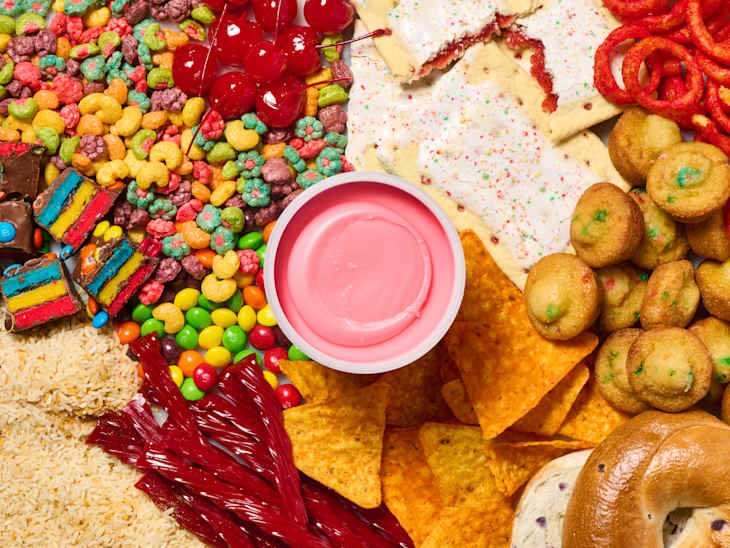


It’s no secret that chronic illness is at an all-time high in the United States. According to the Centers for Disease Control, six in 10 Americans have at least one chronic disease, and four in 10 have at least two. To say we have a problem is an understatement.
We are in the midst of a public health crisis — and to further complicate things, there are wildly different opinions on what to address first. This past March, I was invited to a panel conversation on the New York Food Safety and Chemical Disclosure Act (also known as S1239/A1556) hosted by the Environmental Working Group, an advocacy organization. The invite piqued my interest because of the intense focus on food dyes. It came on the heels of Make America Healthy Again (MAHA) activists and supporters marching to Kellogg’s headquarters to deliver a petition with over 400,000 signatures demanding the manufacturer remove synthetic food dyes from its breakfast cereals, citing their potential harm.
Because this has become a hot topic, I thought it would be valuable to attend and gain some additional insights. The biggest question I had was, how harmful are food dyes?
What’s the difference between artificial and natural food dyes?
Food dyes are widely found in items on grocery shelves today, and come from both artificial (or synthetic) and natural sources. Manufacturers use food dyes to make colors more vibrant, like in a box of fruity-flavored cereal. Most of us eat with our eyes first, and associate brightly colored foods with freshness and better taste, regardless of whether it’s true.
Synthetic dyes are made from petroleum and created in labs. They’re used in food, as well as textiles, leather, paper printing, cosmetics, pharmaceuticals, and technology products; while food dyes made from natural sources often come from ingredients like butterfly pea flower extract, algae, turmeric, curcumin, and calcium phosphate.
Are artificial and natural food dyes actually safe to consume?
Whether a food dye is from synthetic or natural sources, it must be tested. Human-made colors must be approved by the Food and Drug Administration (FDA) for food use; they are also rigorously tested at certain levels to make sure there are no “impurities of toxicological concern” for humans, according to Brittany Tower, a food scientist who runs the @theblackfoodscientist Instagram account.
At the same time, there are a number of documented health risks and concerns related to synthetic dyes and chemical additives, according to the Environmental Working Group (EWG), including potential increases in developing certain cancers, hormone disruption, risks to brain development in children, and behavioral difficulties. This sounds worrisome at best, and can explain why the FDA banned Red No. 3 in January and at least 20 states have introduced bills aimed at restricting or banning synthetic dyes and other food additives.
While natural food dyes are exempt from certification, they still must go through the approval process to ensure they are safe, explains Tower. Once approved they are generally considered safe. (Interestingly, not all colors from natural sources get approved for use in food.)
How the New York Food Safety and Chemical Disclosure Act Could Impact Groceries Across the Country
In my home state of New York there is a bill on the table, which would prohibit the sale and serving of food and drink containing a handful of synthetic dyes, including Blue 1, Blue 2, Green 3, Red 40, Yellow 5 or Yellow 6 in public schools. It would also ban food products containing potassium bromate, propyl paraben, and Red 3 statewide, as well as require food and chemical companies to report the ingredients sold in the state.
While this bill is specific to NY, Jessica Hernandez, policy director on the government affairs team at EWG, notes the state’s large economy has the potential to influence manufacturers toward a country-wide shift. So the potential ripple effect is quite large.
Are synthetic dyes the only problem in the food system? Absolutely not. From my clinical expertise as a Registered Dietitian, I know that removing food dyes doesn’t decrease the amount of sugar in a breakfast pastry.
I find it confusing that there is so much focus on the removal of synthetic food dyes and chemical additives from the food supply when we are in the midst of a public health crisis and living in a country where 80% of people do not eat five fruits and vegetables each day or have reliable access to food. It seems that we would be much better served to focus on making nourishing foods accessible and affordable.
Until then, if you are interested in reducing or removing food dyes from your life, your best bet is to get to know your nutrition facts panel and ingredient list. Food dyes have to be listed. This is where the responsibility falls back on us, the consumer, to make the choices that suit our needs.
Fad or Fact is a monthly column where Maya Feller, MS, RD, breaks down the most important — and, let’s be honest, sometimes confusing — products and trends taking over grocery aisles. Do you have a grocery question or topic you want Maya to cover? Tell us about it in the comments below.
The Weekly Checkout
Sign up for The Weekly Checkout to get the most up-to-date grocery news, tips, and highlights.